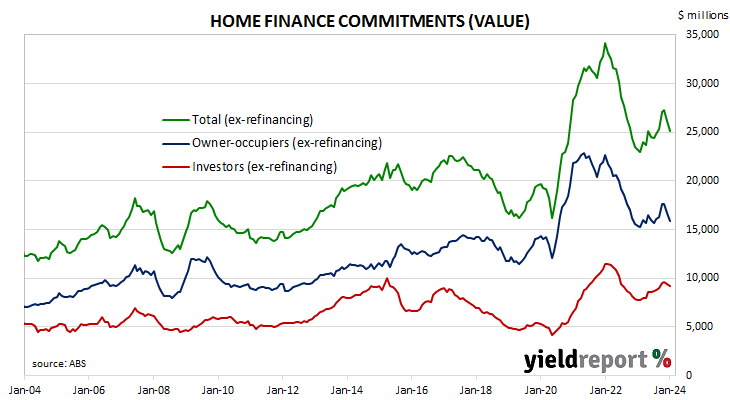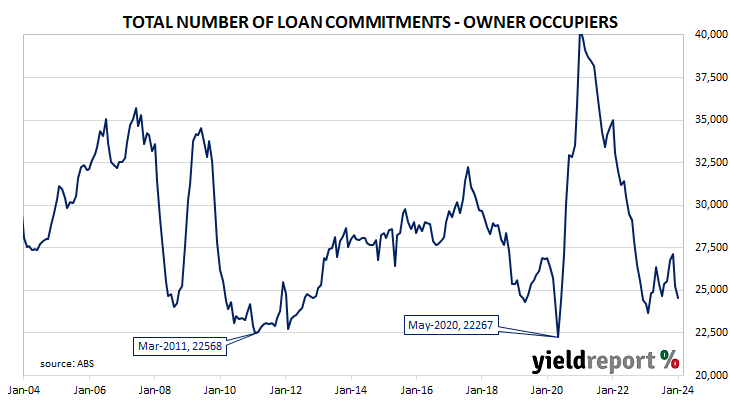Summary: Value of loan commitments down 3.9% in January, contrasts with expected gain; 8.5% higher than January 2023; Westpac: rate rise may had more material influence on housing markets; ACGB yields up a little; rate-cut expectations firm slightly; value of owner-occupier loan approvals down 4.6%; investor approvals down 2.6%; number of owner-occupier home loan approvals down 2.6%; UBS: falls somewhat surprising given dwelling prices growth.
The number and value of home-loan approvals began to noticeably increase after the RBA reduced its cash rate target in a series of cuts beginning in mid-2019, potentially ending the downtrend which had been in place since mid-2017. Figures from February through to May of 2020 provided an indication the downtrend was still intact but subsequent figures then pushed both back to record highs in 2021. However, there has been a considerable pullback since then, although the total value of new loans is still elevated by historical standards.
January’s housing finance figures have now been released and total loan approvals excluding refinancing decreased by 3.9% In dollar terms over the month, in contrast with the 2.0% rise which had been generally expected and quite close to December’s 4.1% fall. On a year-on-year basis, total approvals excluding refinancing were still up 8.5%, down from the previous month’s comparable figure of 11.5%.
“Overall, the update suggests November’s interest rate rise may have had a more material influence on markets,” said Westpac senior economist Matthew Hassan. “Housing turnover weakened into year-end with price growth also softening. Prospects look a little better in early 2024 although gains in finance are likely to remain sluggish.”
Commonwealth Government bond yields crept a little higher on the day. By the close of business, the 3-year ACGB yields had added 1bps to 3.63%, the 10-year yield had returned to its starting point at 4.02% while the 20-year yield finished 1bp higher at 4.34%.
In the cash futures market, expectations regarding rate cuts later this year and early next year firmed slightly. At the end of the day, contracts implied the cash rate would remain close to the current rate for the next few months and average 4.315% through March, 4.30% in April and 4.27% in May. However, August contracts implied 4.135%, November contracts implied 3.96% and February 2025 contracts 3.815%, 52bps less than the current rate.
The total value of owner-occupier loan commitments excluding refinancing decreased by 4.6%, up from December’s 5.6% fall. However, on an annual basis, owner-occupier loan commitments were 3.4% higher than in January 2023, down from 7.0% in December.
The total value of investor commitments excluding refinancing decreased by 2.6%. The fall follows a 1.6% decline in December, taking the growth rate over the previous 12 months from 20.2% to 18.5%.
The total number of loan commitments to owner-occupiers excluding refinancing decreased by 2.6% to 24581 on a seasonally adjusted basis, a smaller fall than December’s 6.9% drop. The annual growth rate slowed from 3.2% after revisions to 1.7%.
“These falls are somewhat surprising, given dwelling prices growth picked up again in recent months, and there was no obvious material change in the trend of volumes or lending standards” said UBS economist George Tharenou. “We presume there will be a bounce in coming months, but the trend now suggests that housing credit growth will be steady ahead, rather than picking up.”



